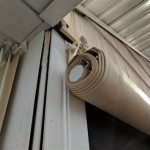How to Measure for Grommet Curtains: A Comprehensive Guide
Grommet curtains, characterized by their evenly spaced metal or plastic rings (grommets) at the top, offer a clean, modern aesthetic. Their design allows for easy sliding and a well-defined, consistent pleat. Accurate measurements are paramount to ensuring a proper fit and achieving the desired visual effect. This article presents a comprehensive guide to measuring for grommet curtains, providing detailed instructions and addressing potential considerations to help achieve professional results.
Determining the Rod Placement
The first step in measuring for grommet curtains involves determining the optimal position for the curtain rod. This decision significantly impacts the overall look and functionality of the curtains. Several factors should be considered, including the height of the ceiling, the size of the window, and the desired light control and privacy levels.
Typically, curtain rods are installed approximately 4 to 6 inches above the window frame. This placement creates the illusion of a taller window and allows more natural light to enter the room when the curtains are fully open. However, for rooms with lower ceilings, a higher placement, such as 6 to 12 inches above the window frame, can visually expand the space. Conversely, in rooms with very high ceilings, a lower placement might be more appropriate to maintain a sense of proportion.
The rod should also extend beyond the width of the window frame on each side. This allows the curtains to be fully drawn back without obstructing the window and maximizing natural light. A common recommendation is to extend the rod 8 to 12 inches beyond the window frame on each side, resulting in a total rod width that is 16 to 24 inches wider than the window itself.
Once the desired rod position is determined, use a measuring tape and a level to mark the location for the rod brackets. Ensure that the brackets are securely mounted to the wall, using appropriate hardware for the wall type (e.g., drywall anchors for drywall, screws into studs for wood framing).
Calculating the Curtain Length
Accurately determining the curtain length is crucial for achieving the desired look and functionality. The length is measured from the top of the curtain rod to the desired bottom edge of the curtain. Several options exist for the finished length, each with its own aesthetic and practical considerations.
Floor-Length Curtains: This is the most common and often preferred length for grommet curtains. Floor-length curtains typically hang just above the floor, creating a clean and elegant look. To achieve this, measure from the top of the rod to the floor, then subtract 1/2 to 1 inch. This slight gap prevents the curtains from dragging on the floor, which can cause them to become dirty and worn.
Puddled Curtains: For a more dramatic and luxurious look, consider puddled curtains. These curtains extend beyond the floor, creating a soft, romantic drape. To achieve this effect, measure from the top of the rod to the floor, then add 2 to 6 inches, depending on the desired amount of pooling. Keep in mind that puddled curtains require more fabric and may not be suitable for high-traffic areas.
Sill-Length Curtains: Sill-length curtains end at the windowsill. This length is often used in kitchens or bathrooms where longer curtains might be impractical. Measure from the top of the rod to the windowsill to determine the correct length.
Apron-Length Curtains: Apron-length curtains fall just below the windowsill. This length provides a slightly more formal look than sill-length curtains and is often used in dining rooms or living rooms. Measure from the top of the rod to approximately 4 to 6 inches below the windowsill.
When measuring for curtain length, it is essential to use a steel measuring tape for accuracy. Fabric measuring tapes can stretch and provide inaccurate readings. Additionally, measure in several locations along the window to account for any variations in the floor or windowsill height.
Determining the Curtain Width
The width of the curtain panels is equally important as the length. Sufficient width ensures that the curtains provide adequate coverage and create a full, pleated appearance when closed. Insufficient width will result in flat, stretched curtains that do not provide adequate privacy or light control.
To determine the correct curtain width, measure the total width of the curtain rod (including the extensions beyond the window frame). This measurement represents the total width that the curtains need to cover. However, the fabric width required will be significantly larger to create the desired fullness and pleats.
A general rule of thumb is to multiply the rod width by a factor of 2 to 2.5. This "fullness factor" accounts for the folds and pleats created by the grommets. For example, if the rod width is 80 inches, the total fabric width required would be between 160 inches (80 x 2) and 200 inches (80 x 2.5).
Most grommet curtains are sold in individual panels. Therefore, the total fabric width needs to be divided by the number of panels desired. For example, if the total fabric width required is 160 inches and two panels are desired, each panel should be 80 inches wide. If four panels are desired, each panel should be 40 inches wide.
Note that ready-made grommet curtains often come in standard widths. Select the ready-made panel size that is closest to, but not smaller than, the calculated width per panel. If the calculated width falls between two standard sizes, it is generally better to choose the larger size to ensure adequate fullness.
When selecting ready-made curtains, pay attention to the "finished width" specification. This indicates the actual width of the curtain panel after the grommets have been installed and the fabric has been pleated. The finished width is typically less than the actual fabric width due to the pleating effect of the grommets.
Accounting for Grommet Placement and Heading
Grommet curtains have a specific construction that affects the overall length and look. The grommets themselves are typically spaced evenly along the top of the curtain panel, and there is often a "heading" above the grommets. The heading is the fabric that extends above the top of the grommets and provides a finished edge.
When measuring for length, it's important to understand that the length is measured from the top of the curtain rod to the desired bottom edge of the curtain. The heading above the grommets is already factored into this measurement. However, the location of the grommets relative to the top of the fabric panel can affect the overall drop.
Ideally, the product description of the grommet curtains will specify the distance from the top of the panel to the top of the grommet. This information can be used to fine-tune the length measurement. If this information is not available, it is generally safe to assume that the top of the grommet is approximately 1 to 2 inches below the top of the fabric panel.
The heading above the grommets also contributes to the overall look of the curtain. A larger heading can create a more formal and structured appearance, while a smaller heading can provide a more casual and relaxed look. Consider the desired aesthetic when selecting grommet curtains with different heading heights.
Considering Lining and Interlining
When measuring for grommet curtains, consider whether the curtains will be lined or interlined. Lining refers to a layer of fabric attached to the back of the curtain panel, while interlining refers to a layer of fabric between the face fabric and the lining. Both lining and interlining can enhance the appearance, performance, and longevity of the curtains.
Lining provides several benefits, including improved light control, increased privacy, and enhanced insulation. It can also protect the face fabric from fading and damage caused by sunlight. When adding a lining, the overall length measurement may need to be adjusted slightly to account for the added thickness of the fabric.
Interlining provides even greater benefits than lining. It adds significant body and fullness to the curtains, creating a more luxurious and dramatic appearance. It also improves insulation and sound absorption. When adding interlining, the overall width and length measurements may need to be adjusted more significantly to account for the added thickness of the fabric.
If the grommet curtains are being custom-made, be sure to specify whether lining or interlining is desired and provide accurate measurements to the fabricator. If purchasing ready-made curtains, check the product description to see if lining or interlining is included. If not, consider adding a separate lining or interlining fabric to the back of the curtains to achieve the desired benefits.
Accurate measurements are the foundation of successful grommet curtain installation. By carefully considering rod placement, curtain length, curtain width, grommet placement, and the potential addition of lining or interlining, can ensure that the curtains fit properly and enhance the aesthetic appeal of the space.

How To Measure For Grommet Top Curtains Vermont Country

Grommet Measuring And Fabrication

Measuring Guide Kgorge

Custom Outdoor Curtains With Large 12 Grommets Recommended

How To Measure A Window For Curtains

How To Measure For Curtains Graham Brown

Drapery Measuring Instruction Twopages Curtains

How To Measure For Grommet Top Curtains

Custom Drapery Panel Grommet

Youtube








